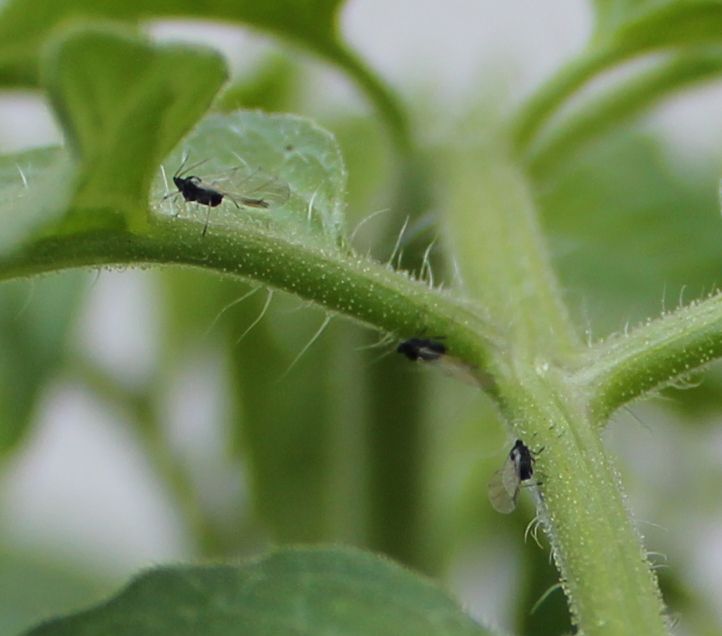Tomato plants are susceptible to infestations from many different pests, including little flies. These small insects can quickly multiply and cause major damage if left uncontrolled. As a tomato gardener, it’s important to know how to identify, prevent, and get rid of little flies so your plants can thrive.
Identifying Little Flies on Tomato Plants
The most common little flies found on tomato plants are:
-
Whiteflies – These are small, moth-like insects that are usually found on the undersides of leaves. They can cause yellowing, distorted growth, and sticky honeydew secretion.
-
Fungus gnats – These tiny black flies are attracted to moist soil and decaying plant matter. Their larvae can damage roots while the adults spread fungal diseases.
-
Shore flies – Similar to fungus gnats but slightly larger. They reproduce quickly and the larvae feed on algae, fungi, and decaying organic matter
-
Fruit flies – Tiny flies that feed on ripe or overripe tomato fruits They are attracted by the smell and can enter through cracks in the skin
Pay close attention to the undersides of leaves, soil, ripening fruits, and damaged areas to check for the presence of flies. Sticky traps can also help monitor populations. Act quickly at the first signs of infestation before they multiply.
Preventing Little Fly Infestations
An ounce of prevention is worth a pound of cure when it comes to pest control. Here are some tips to help prevent little flies on tomato plants:
-
Remove weeds, dead leaves, and decaying fruit/vegetables from the garden to eliminate breeding grounds.
-
Allow the top layer of soil to dry out between waterings to deter fungus gnats and shore flies.
-
Use sticky traps early in the season to monitor for adults.
-
Cover ripening fruits with mesh bags to create a barrier against fruit flies.
-
Introduce beneficial insects like ladybugs, lacewings, and predatory mites that feed on fly larvae.
-
Practice crop rotation and avoid over-fertilization which can make plants more susceptible to flies.
Getting Rid of Little Flies on Tomato Plants
If you already have an infestation, here are some effective and natural ways to get rid of little flies:
Insecticidal Soaps
Insecticidal soaps containing potassium salts of fatty acids can help control fly populations when sprayed directly on plants. Spray the undersides of leaves to target larvae and eggs. Apply weekly until infestation clears.
Neem Oil
Neem oil is extracted from the seeds of the neem tree. It disrupts the life cycle and kills many insect pests. Mix 1 teaspoon neem oil with 1 quart water and a few drops of dish soap. Spray on tomato plants, especially the underside of leaves. Reapply every 7-14 days.
Diatomaceous Earth
This powder made from fossilized algae has microscopic jagged edges that damage soft-bodied insects like larvae and adult flies. Apply a thin layer on the soil around plants. Reapply after rain or watering. Wear a mask when handling.
Beneficial Nematodes
These microscopic roundworms attack and kill fly larvae in the soil. Apply nematodes early in the season or at first signs of fungus gnats. Water soil before and after application for best results.
Yellow Sticky Traps
Traps like yellow sticky cards can help monitor and reduce flying adult populations. Stick traps just above soil level for fungus gnats and shore flies and hang traps in plant foliage for whiteflies.
Sanitation
Remove and destroy heavily infested plant parts. Discard overripe or fallen fruits/vegetables and prune dead leaves to eliminate fly breeding spots.
With diligence and using a combination of these methods, it’s possible to get little flies under control. Always follow organic principles and avoid broad spectrum pesticides that can harm beneficial insects. Check plants regularly and act quickly at first signs of flies before they multiply and get out of hand. Healthy tomatoes and abundant harvests will be your reward!

Step 1: Water less often[image id=”34362″ size=”landscape_thumbnail” align=”none” title=”Watering the compost” alt=”Watering the compost” classes=””] Watering the compost
Fungus gnat larvae need damp compost to live, as this is where algae and fungi thrive, on which the larvae feed. Simply by allowing the compost dry out between waterings, you’ll greatly reduce the fungus gnat population.
Step 2: Use a gravel mulch[image id=”34363″ size=”landscape_thumbnail” align=”none” title=”Covering the compost with gravel” alt=”Covering the compost with gravel” classes=””] Covering the compost with gravel
Most commercially available composts have been sterilised, so they don’t contain fungus gnat larvae. If you cover the surface of the compost with a 1cm-thick mulch of gravel, grit or ornamental glass pebbles, this will stop house plant flies from being able to lay their eggs. Avoid using home-made garden compost indoors, as this can be a source of fungus gnats.
How to Get Rid of Flies in a Potted Tomato Plant : The Chef’s Garden
FAQ
How to get rid of little white flies on tomato plants?
Remove infested leaves as soon as you detect them. Hose off your tomato plants with water, which will remove the adults.Jul 17, 2020
Will gnats hurt my tomato plants?
Yes, fungus gnats. They can kill brand new seedlings, which is what happened to my tomato babies.
How do I get rid of little flies on my plants?
Use yellow houseplant sticky stakes
Yellow sticky traps are great for capturing adult fungus gnats and also help you gage which plants are the most infested. Put the sticky fly traps next to the soil of any indoor plants, they’ll be attracted to the bright colors, fly into them and get stuck.
